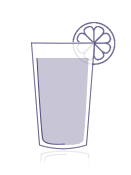
Benedictine
- Category: Liqueurs
- Volume: 40%
Benedictine is a strong French liqueur.
It is claimed that in the Benedictine abbey in Fecamp in Normandy monks developed a medicinal aromatic herbal drink, which was produced until the destruction of the abbey during the French Revolution. But there is a version that Alexander Le Grand actually invented the recipe himself, with the support of a local chemist, and he told this story to link the liqueur to the history of the city, to increase sales. He started production under the trade name 'Bénédictine', using a bottle with a recognizable shape and label. Rich on liqueur, enterprising Le Grand built a luxurious museum-palace in Fecamp, naming it 'The Palace of Benedictine'. Eventually the family sold the company to Martini and Rossi, who in turn handed it over to Bacardi.
The recipe is a carefully guarded trade secret, supposedly only revealed to three people at any given time. Among the known components are juniper, saffron, arnica, balm, tea, thyme, coriander, clove, lemon, vanilla, orange peel, honey and cinnamon. So many people have tried to reproduce the recipe that the manufacturer maintains a 'Hall of Counterfeit Goods' (Salle des Contrefaçons) in Fecamp. On the label of each bottle of Benedictine the initials D.O.M., which stand for 'Deo Optimo Maximo', which translates as 'To God, the Best, the Greatest' and is the motto of the Benedictine Order.



